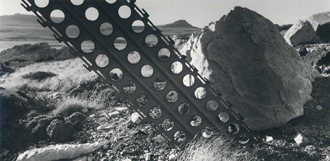13 March 2002
The Falklands - 20 years on

An exhibition at the Imperial War Museum, London, (23 March to 23 June
2002) mounted to mark the twentieth anniversary of the Falklands
conflict, contains interactive, digital and print-based media by Roland Ashcroft,
Gareth Fisher, Gary Gowans and Elaine Shemilt of the University of
Dundee.
These artists are of the same generation as those who fought on both
sides in 1982. Their work is a response to their own poignant memories of
twenty years ago as well as their feelings when they saw first hand the traces of
war that remain on the Falkland Islands. All four artists belong to
Duncan of Jordanstone faculty of art and design at the University of Dundee.
Using sound together with historic and contemporary photographs,
collaged with watercolours, print media, found items and computer-generated
imagery by all four artists, they have worked together to create an interactive
programme that will be projected onto one wall of the gallery. Original
works by all four artists will also be displayed.
Twenty years after the 1982 Anglo/Argentinean conflict Elaine Shemilt
reflects, the remaining evidence of the war is still visible in the
landscape: minefields, war debris, war graves suggesting the contrast of
past and present that is integral to her work. During her visits to the
shattered refrigeration plant at Ajax Bay, the site of the 1982 field
hospital, she recorded: "I have felt as though the ghost of my self
twenty years ago was haunting those ruins. I am also aware that my sons have
reached the age when many of those young men involved in the fighting
lost their lives." This is the essence of " Fragments" which is the series of
images made for the Imperial War Museum Exhibition 'Traces of Conflict'
in 2002.
 For Gareth Fisher it was Mount Harriet, where personal belongings -
clothing, shoes, a book, tins and bottles, as well as rusting armaments
lie undisturbed. "The ruins of military architecture and installations,
wrecked vehicles and equipment are the antithesis of sublime; the new modern
graveyards, they are awesome reminders of death and loss, more potent
than official memorials." His works take the form watercolours, underpinned
with drawing, which sub consciously try to evoke broad visual panoramas from
Mount Harriet. Sometimes almost abstract, but pulled back to a realistic
reference point, by collaging a photograph from the location into the
work.
For Gareth Fisher it was Mount Harriet, where personal belongings -
clothing, shoes, a book, tins and bottles, as well as rusting armaments
lie undisturbed. "The ruins of military architecture and installations,
wrecked vehicles and equipment are the antithesis of sublime; the new modern
graveyards, they are awesome reminders of death and loss, more potent
than official memorials." His works take the form watercolours, underpinned
with drawing, which sub consciously try to evoke broad visual panoramas from
Mount Harriet. Sometimes almost abstract, but pulled back to a realistic
reference point, by collaging a photograph from the location into the
work.
Families come and leave flowers, photographs and personal mementoes
attached to the simple white wooden crosses that mark the graves of
Argentine soldiers. Roland Ashcroft found the Argentine Cemetery very
moving because it was so openly about grief and loss. He was also struck
by contrasts, the military and civil communities, the barren landscape and
wild southern ocean, the debris of war and the growth of a community and
the contrast between life and death focused by the tragic loss of
hundreds of British and Argentine men. His photographic work involves extremes
and contrasts and hints at their reaching out towards each other.
Garry Gowans' perspective comes from how he experienced the conflict
remotely at home in Scotland; "I watched the war from my living room, in
pubs, cafes and shop windows - on television. Initial disbelief turned
to incredulity as intermittent incidents escalated to full blown conflict."
His work juxtaposes television coverage of the events with animated
imagery referencing key incidents. Christian iconography reminded him of common
aspects of faith, loss and remembrance whilst imagery collected from his
own trips to the islands points to the harsh, yet beautiful and
ecologically unique environment./ENDS
The artists will be available for interview on Friday 15 March and
Monday 18 March. They can be contacted at the following numbers at the
University of Dundee.
Elaine Shemilt 01382 345145
Gareth Fisher 01382 345460
Roland Ashcroft 01382 345303
Gary Gowans 01382 345571
Image captions
Garry Fisher: Communications
Roland: Military Debris and Argentine War Grave
 For Gareth Fisher it was Mount Harriet, where personal belongings -
clothing, shoes, a book, tins and bottles, as well as rusting armaments
lie undisturbed. "The ruins of military architecture and installations,
wrecked vehicles and equipment are the antithesis of sublime; the new modern
graveyards, they are awesome reminders of death and loss, more potent
than official memorials." His works take the form watercolours, underpinned
with drawing, which sub consciously try to evoke broad visual panoramas from
Mount Harriet. Sometimes almost abstract, but pulled back to a realistic
reference point, by collaging a photograph from the location into the
work.
For Gareth Fisher it was Mount Harriet, where personal belongings -
clothing, shoes, a book, tins and bottles, as well as rusting armaments
lie undisturbed. "The ruins of military architecture and installations,
wrecked vehicles and equipment are the antithesis of sublime; the new modern
graveyards, they are awesome reminders of death and loss, more potent
than official memorials." His works take the form watercolours, underpinned
with drawing, which sub consciously try to evoke broad visual panoramas from
Mount Harriet. Sometimes almost abstract, but pulled back to a realistic
reference point, by collaging a photograph from the location into the
work.
